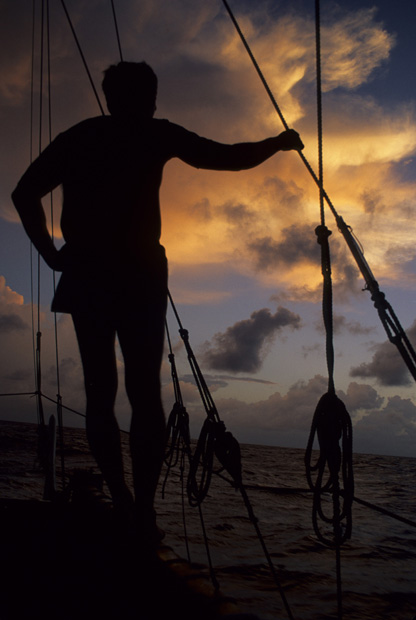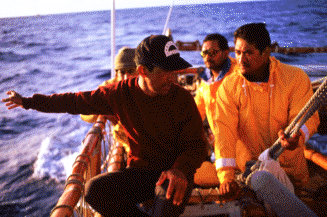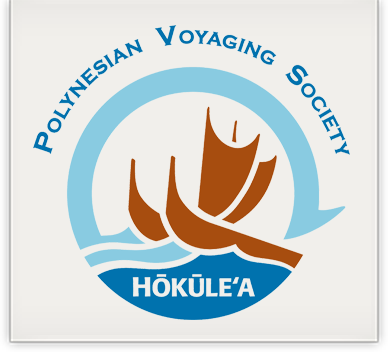
Wayfinding: Modern Methods and Techniques of Non-Instrument Navigation, Based on Pacific Traditions
Before the invention of the compass, sextant and clocks, or more recently, the satellite-dependant Global Positioning System (GPS), Pacific Islanders navigated open-ocean voyages without instruments, using instead their observations of the stars, the sun, the ocean swells, and other signs of nature for clues to direction and location of a vessel at sea.
Before the invention of the compass, sextant and clocks, or more recently, the satellite-dependant Global Positioning System (GPS), Pacific Islanders navigated open-ocean voyages without instruments, using instead their observations of the stars, the sun, the ocean swells, and other signs of nature for clues to direction and location of a vessel at sea.
In the 20th century, this method was still practiced in some areas of Micronesia, although the traditional knowledge and techniques are in danger of being lost because of modernization and Westernization of the island cultures.
 A revival of the art and science of wayfinding is underway among the Pacific islands, led by Nainoa Thompson, the first modern-day Polynesian to learn and use wayfinding for long-distance, open-ocean voyaging. Nainoa studied wayfinding under Mau Piailug, a master navigator from the island of Satawal in Micronesia. He also studied the movement and positioning of celestial bodies with Will Kyselka at the Bishop Museum planetarium in Honolulu, and oceanography and meteorology at the University of Hawai‘i.
A revival of the art and science of wayfinding is underway among the Pacific islands, led by Nainoa Thompson, the first modern-day Polynesian to learn and use wayfinding for long-distance, open-ocean voyaging. Nainoa studied wayfinding under Mau Piailug, a master navigator from the island of Satawal in Micronesia. He also studied the movement and positioning of celestial bodies with Will Kyselka at the Bishop Museum planetarium in Honolulu, and oceanography and meteorology at the University of Hawai‘i.
Mau navigated the first voyage of the Hokule’a to Tahiti in 1976; Thompson served as wayfinder on voyages of Hokule‘a in 1980 and 1985-87. In 1992, he began training new navigators from Hawai’i and other Pacific islands to perpetuate the tradition.
A voyage undertaken using modern wayfinding has three components:
- Designing a course strategy, which includes a reference course for reaching the vicinity of one’s destination, hopefully upwind, so that the canoe can sail downwind to the destination rather than having to tack into the wind to get there. (Tacking involves sailing back and forth as closely as possible into the wind to make progress against the wind; it’s very arduous and time-consuming, something to be avoided if at all possible, particularly at the end of a long, difficult voyage.)
- During the voyage, holding as closely as possible to the reference course while keeping track of (1) distance and direction traveled; (2) one’s position north and south and east and west of the reference course and (3) the distance and direction to the destination.
- Finding land after entering the vicinity of the destination, called a target screen or “the box.”
Bibliography – Wayfinding and Astronomy
- Andrews, Lorrin. A Dictionary of the Hawaiian Language. Rutland, VT: Tuttle, 1974. (First published in 1965.)
- Beckwith, Martha. Hawaiian Mythology. Honolulu: UH Press, 1970. (First published in 1940 by Yale University Press.)
- ______________. The Kumulipo: A Hawaiian Creation Chant. Honolulu: UH Press, 1972. (First published in 1951 by the University of Chicago Press.)
- Corney, B.G. (ed.), The Quest and Occupation of Tahiti by Emissaries of Spain during the Years 1772-6 (3 vols.), London: Hakluyt Society, 1913-1919, Vol. II, 284-287.
- Finney, Ben. “Voyaging into Polynesia’s Past” in From Sea to Space. New Zealand: Massey University, 1992.
- Finney, Ben. Voyage of Rediscovery: A Cultural Odyssey Through Polynesia. Berkeley: University of California, 1994.
- Johnson, Rubellite Kawena, and John Kaipo Mahelona. Na Inoa Hoku: A Catalogue of Hawaiian and Pacific Star Names. Honolulu: Topgallant, 1975.
- Kane, Herb Kawainui, et al. “Steering by Stars and Seas” in Polynesian Seafaring Heritage, ed. by Cecilia Kapua Lindo and Nancy Alpert Mower. Honolulu: Kamehameha Schools, 1980.
- Kepelino. Traditions of Hawaii. Edited by Martha Beckwith. Honolulu: Bishop Museum, 1932.
- Kyselka, Will. An Ocean in Mind. Honolulu: University of Hawaii Press, 1987.
- Kyselka, Will, and Ray Lanterman. North Star to Southern Cross. Honolulu: University of Hawaii Press, 1976.
- Gladwin, Thomas. East Is a Big Bird. Cambridge: Harvard University Press, 1970.
- Grimble, Rosemary, Grimble, Rosemary, ed. Migrations, Myths, and Magic from the Gilbert Island: Early Writing of Sir Arthur Grimble. London: Routledge & Kegan Paul, 1972.
- Grimble, Sir Arthur. Tungaru Traditions: Writing on the Atoll Culture of the Gilbert Islands. Honolulu: University of Hawai’i Press, 1989.
- Lewis, David. The Voyaging Stars: Secrets of the Pacific Island Navigators. New York: W.W. Norton, 1978.
- Lewis, David. We, the Navigators: The Ancient Art of Landfinding in the Pacific. 2nd Edition. Honolulu: University of Hawaii Press, 1994.
- Lyman, Dave. “Pitch and Roll” in Polynesian Seafaring Heritage, ed. Cecilia Kapua Lindo and Nancy Mower. Honolulu: Kamehameha Schools, 1980.
- Makemson, Maud W. “Hawaiian Astronomical Concepts. Part I and Part II” American Anthropologist, 1938.
- Makemson, Maud W. The Morning Star Rises. New Haven: Yale University Press 1941.
- Pukui, Mary Kawena, and Samuel H. Elbert. Hawaiian Dictionary. Honolulu: UH Press, 1971.
- Thompson, Nainoa. Lectures, Notes, and Conversations. 1991-1998.
Related Websites (Astronomy)
- Stellarium (Online Planetarium): www.stellarium.org
- Sky charts and planetary/sun/moon info: www.heavens-above.com
- NASA Eclipse Website: http://eclipse.gsfc.nasa.gov/eclipse.html
